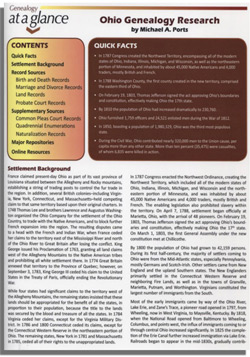
|
|
|
| Product Information: | ||
| Details: | Genealogy at a Glance: Ohio Genealogy Research; by Michael A. Ports; 4 pp., folded, Laminated; 203 pp; 8.5x11; 2015; ISBN: 9780806320137; Item #GPC4667 As part of the Northwest Territory, Ohio was opened for settlement in 1787. Within a few years, when its boundaries were formally established, Ohio became the 17th state in the Union, with a population of about 50,000. By 1810 the population swelled to 230,000. After the development of the National Road and the Erie Canal, the original settlers from the mid-Atlantic states (mostly Pennsylvania-Germans and Scotch-Irish), were joined by Irish and German immigrants, expanding the population to 2 million. The records left by these early settlers and immigrants can be found in county courthouses from Washington County (created in 1791) to Noble County (created in 1851), though most of them are centralized under the Ohio Network of American History Research Centers, positioned geographically around the largest metropolitan areas and coordinated by the Ohio History Center in Columbus. Genealogical records for most counties are fairly complete, especially early land records and the quadrennial enumerations, which were taken every four years from 1803 to 1911. So the question is, what is the most efficient way to access these records? We think the best way is to use a guide that offers a quick overview of records, record repositories, and online resources, directing you, without any prior training, straight to your goal. This is precisely what Michael Ports’s Ohio Genealogy Research is designed for. Like other publications in the Genealogy at a Glance (GAAG) series, Ohio Genealogy Research is a four-page laminated folder designed to cover the basic elements of genealogical research at a glance. The Ohio GAAG provides an overview of the facts you need to know in order to begin and proceed successfully with your research. Focusing on traditional record sources such as vital records, court records, land records, and probate records, it contains useful tips, research advice, analysis of the major record sources used in Ohio research, and clues to finding those records in state and local repositories. A handy and practical guide for the beginner, Ohio Genealogy Research also includes lists of books for further reference and a list of the principal online resources. In addition, it contains a comprehensive list of Ohio repositories and their websites, and in the spirit of the Genealogy at a Glance series, it attempts to fill in every gap in the beginner’s toolbox. See the others in "Genealogy at a Glance" series:”
|
|

